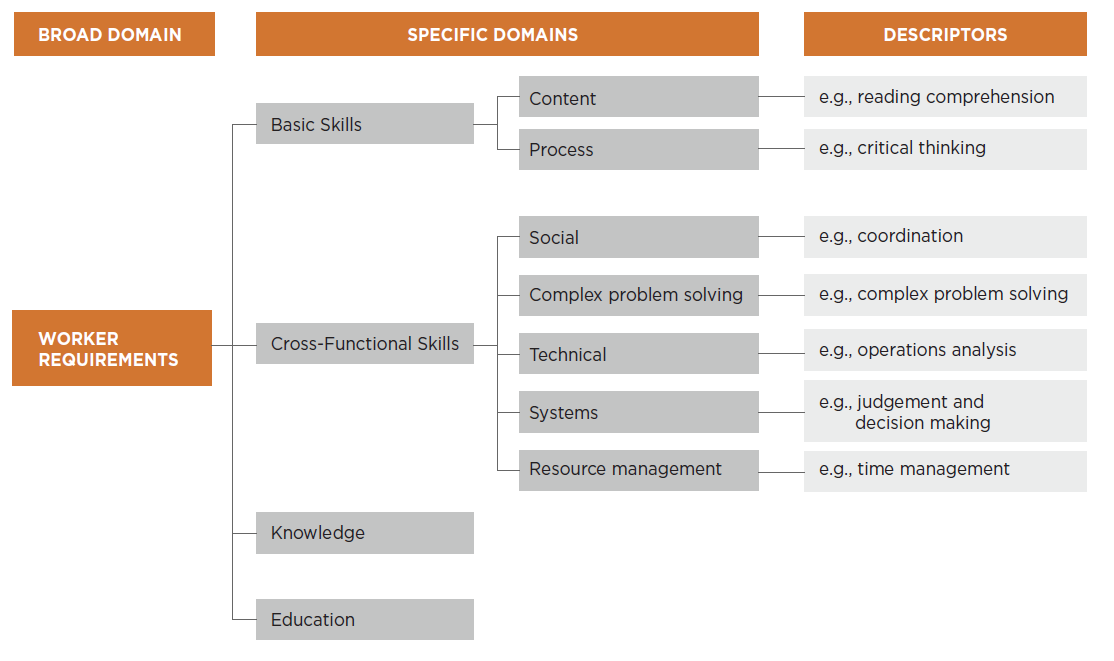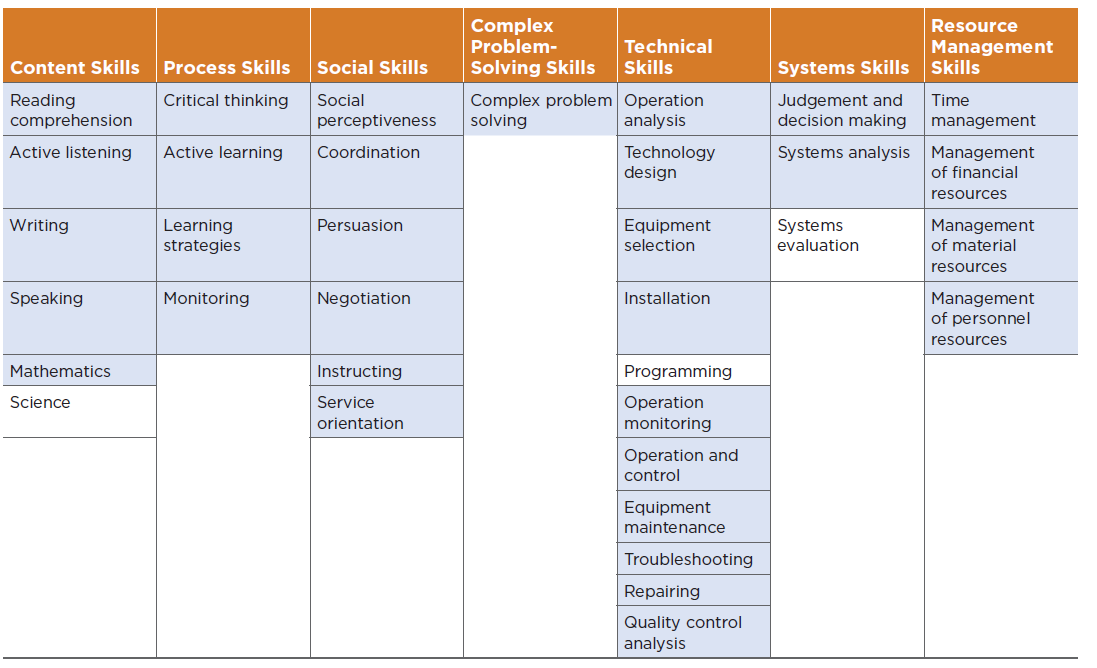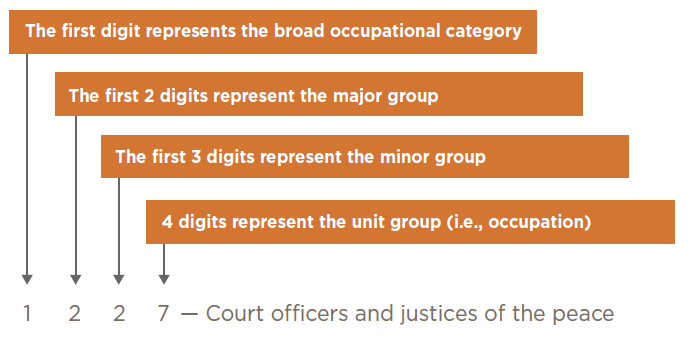Table of Contents
Key Findings
- The US O*NET database represents one of the world’s largest, most comprehensive, widely used public repositories documenting detailed job-worker characteristics. This includes, among others, importance and complexity measures for 35 skills across 968 occupations.
- To leverage O*NET information, such as the skills ratings, in the Canadian context, Employment and Social Development Canada and Statistics Canada are collaborating to develop a rigorous, multi-layered concordance (or "mapping") between the US and Canadian occupational classification systems.
- With this concordance, US occupations in O*NET can be mapped to Canadian occupations and empirical insights drawn from the skills (as well as other job-worker characteristics) associated with them. For instance, one could calculate the percentage of job vacancies for which a certain skill level is associated, the share of workers in occupations for which a skill is rated as "very important," or the average skill level for the fastest growing occupations, to name a few applications. In the context of COVID-19, the O*NET system has also been used to draw insights on occupations that require the worker to perform job tasks in close physical proximity to other people.
- In showcasing possible indicators that can be developed using O*NET, it is important to be transparent about the limitations of the data and how it is constructed. These limitations include, for example, that 1) skill ratings in the American system are difficult to interpret; 2) data are updated only for a small set of occupations each year (those considered in-demand); and, 3) ratings represent averages, which do not capture skill differences across industry or geography.
- Translating O*NET data to the Canadian context leverages existing data in an efficient, cost- effective way. Furthermore, being transparent about the limitations of O*NET data helps guide users on how the information should be used and interpreted. This exercise may also help to inform the development of a future Canadian system by highlighting potential improvements that need to be made, including the development of additional approaches to improve upon this and other available sources of skills information. For instance, data from online job postings are currently being explored as a tool for augmenting the skills associated with occupations.
Introduction
In LMI Insight Report no. 16, Employment and Social Development Canada (ESDC), Statistics Canada (STC) and the Labour Market Information Council (LMIC) jointly noted that a statistically robust linkage between ESDC’s Skills and Competencies Taxonomy and the National Occupation Classification (NOC) system would position Canada to better articulate the composition and distribution of skills across jobs. This information is needed to facilitate defining and measuring skills in the context of a rapidly changing world of work.
As a result, the three organizations partnered to research, identify and assess various methods for linking job-worker characteristics, with a focus on mapping skill requirements to occupations in a consistent manner. We identified several potential methods, from relying on occupational experts to using automated techniques that combine statistical learning algorithms with natural language processing.
In this joint report, we examine one of the most widely used frameworks connecting job and worker characteristics to occupations: the United States’ Occupational Information Network (O*NET). The O*NET system relies on occupational experts to link the importance and level (i.e. proficiency) of skills to occupations. We also explore the possibilities of applying these importance and level ratings in the US O*NET system to Canadian occupations, as defined in the National Occupational Classification (NOC) system, to create profiles and analytical insights on the skills in demand in Canadian labour markets.
O*NET at a Glance
O*NET is an online database that provides standardized information about the characteristics of jobs and workers in the United States. Created originally as an update to the now-superseded Dictionary of Occupational Titles (DOT), it functions primarily to support individuals in making career and educational decisions, and to provide tools to create and maintain a globally competitive workforce (National Research Council, 2010). Used by researchers, policy makers, workforce development and HR professionals, job seekers, students, and others around the globe for a variety of purposes, O*NET can help estimate work exposures related to health and safety, draw insights on skills shortages, and identify job transition pathways for disrupted workers.
Box 1: Skill Importance and Level Rating Methodology
To associate skills with US occupations, O*NET relies on 16 specialized occupational analysts to interpret occupational data and make determinations about the importance and level of each skill in the O*NET taxonomy. They follow standardized procedures that guide the review of detailed occupational information (called stimulus material), which includes, for example, the title and definition of the occupation, the level of vocational preparation needed and the average importance scores of core and supplementary tasks.
The occupational analysts then proceed to rate skills by importance and level. The importance rating is driven by the review of the occupation title and definition as well as other information from the O*NET system about the occupation’s tasks, knowledge domain, work activities and work context. The importance ratings for these other categories of job descriptors are, in turn, the result of surveys completed by job incumbents in the specific occupation.
Occupation level ratings are determined by comparing the important tasks associated with the job and the anchor statement provided for the specific task (see Figure 2). This initial level rating is then revised as the occupational analyst compares the anchor statement against the knowledge domain, work activity and work context ratings, again determined by surveying individuals working with those occupations.
O*NET’s Breadth
O*NET consists of two main components. First, a content model forms the organizational or structural backbone of the database. This hierarchical taxonomy of occupational descriptors is organized into six "broad domains": 1) worker characteristics, 2) worker requirements, 3) experience requirements, 4) occupational requirements, 5) occupation-specific information, and 6) workforce characteristics. Each broad domain is then divided into "specific domains," under which fall sets of "descriptors." Second, the electronic database itself is composed of the actual data. This includes various measurements associated with some descriptors, such as importance, level and relevance scores, as well as additional data like median wages and projected employment growth. The O*NET Center also has a suite of tools to facilitate using the database.
Skills Domains
The O*NET content model classifies skills into two mutually exclusive categories - basic skills and cross-functional skills - both organized under the broad domain of "worker requirements". The 35 skill descriptors (see Table 1) were originally identified by the O*NET prototype development team.1 These 35 descriptors are aggregated into seven mutually exclusive sub-categories: 1) content skills, 2) process skills, 3) social skills, 4) complex problem-solving skills, 5) technical skills, 6) systems skills, and 7) resource management skills (see Figure 1).
Figure 1: Worker Requirements, Skills and Related Descriptors

Table 1: The 35 O*NET Skill Descriptors Grouped in 7 Sub-categories

Note: Skills included in the skills domain of ESDC’s Skills and Competencies Taxonomy are highlighted in blue. It should be noted that "Programming" will be included in the next version of the Taxonomy (or embedded within the Digital descriptor).
For each of the 968 O*NET data-level occupations,2 all 35 skills are assessed according to importance and level by trained occupational analysts (see Box 1). Importance ratings are assigned values from 1 to 5, where 1 means the skill is not important to that occupation and 5 means the skill is extremely important. If the skill importance rating is 2 or higher, a level rating (from 1 to 7) for that skill is determined based on an anchor scale (see Figure 2). The level rating measures the degree of complexity at which the skill must be executed in the occupation. Both importance and level ratings are standardized to a value ranging from 0 to 100 to make the scores consistent and understandable to users. 3
Thus, for any of the 968 occupations in O*NET, there are 35 skills with importance and level scores available. For illustrative purposes, the O*NET skills profile for human resources managers is shown in Appendix A.
Figure 2: Level Anchor for the Skill "Reading Comprehension"
| 1 | 2 | 3 | 4 | 5 | 6 | 7 |
| Read step-by-step instructions for completing a form |
Read a memo from management describing new personnel policies |
Read a scientific journal article describing surgical procedures |
Leveraging O*NET for Canadian Skills Insights
Given the wealth of skills information at the occupational level available in the US O*NET database, it is important to explore how we might draw insights about job and worker characteristics in Canada. Specifically, there are two considerations.
First, the O*NET database classifies occupations differently from the way occupations are classified in Canada (see Appendix B); thus, using O*NET data in the Canadian context requires the "translation" or mapping of the US occupational codes into Canadian occupational codes - a process achieved via a concordance (see Box 2). In practice, this involves navigating up to four different coding schemes, which makes the process of equating Canadian occupations to O*NET’s occupational titles a challenge. Specifically, occupations in one classification may be more, less, or equally granular than another, potentially leading to information loss.
Second, of the 35 skill descriptors available in O*NET, 32 are integrated into the 47 skill descriptors in the skills domain of ESDC’s Skills and Competencies Taxonomy (see Table 1), leaving 15 skills for which there are no O*NET ratings. By itself then, O*NET alone is insufficient as a data source, necessitating additional methods to complete the skills profiles of occupations in Canada.
Box 2: In the Works: Developing a US (SOC) to Canadian (NOC) Crosswalk
In Canada, various governmental and nongovernmental organizations, such as RBC, the Brookfield Institute for Innovation and Entrepreneurship, and British Columbia’s Ministry of Advanced Education, Skills and Training have built concordances between US and Canadian occupational classification systems in order to assess the skills and competencies of different segments of the Canadian labour market.
Existing concordances, however, lack the granularity to create specific, detailed occupational descriptions. The challenge lies principally in the fact that most occupations do not have a neat, one-to-one mapping from the Canadian National Occupational Classification (NOC) to the US Standard Occupational Classification (SOC). For instance, the US system has three occupations distinguishing Mathematicians (15- 2021), Statisticians (15-2041) and Actuaries (15-2011) for which there is one occupation in the Canadian NOC (namely, 2161). In the absence of more detailed mapping, any such O*NET profile runs the risk of being improperly combined into a single or multiple NOC profile.
Mapping O*NET to Canadian Occupations
Preliminary work has begun to link detailed Canadian occupations to those of O*NET. In some cases, one Canadian occupation might be associated with multiple O*NET occupations, or vice versa. In these one-to-many and many-toone linkages, complications arise in how to apply O*NET skills ratings to the Canadian occupation. This issue is the topic of a forthcoming LMI Insight Report. This difficulty does not arise with one-toone mappings -when a Canadian occupation is uniquely aligned with a single O*NET occupation, as shown in Table 2.
Currently, 149 Canadian occupations can be directly mapped from the 4-digit to 5-digit NOC, and then from the 5-digit NOC to the 8-digit O*NET-SOC. One of these ("Legislators") is not associated with any skills ratings in O*NET.4 Dropping this one case and working at the 4-digit NOC level for the remaining 148 occupations allows us to make empirical insights because this is the most detailed level at which statistical data such as the Labour Force Survey (LFS) are available. Moreover, it allows us to create more accurate career exploration tools and analyze skill transferability.
The sample of one-to-one correspondences between the US SOC and Canadian NOC systems shown in Table 2 are illustrative only. To further highlight the numerous possibilities for using the US O*NET system to extract insights on the composition of skills in the Canadian workforce, Table 3 presents several examples of the type of skills information that can be inferred at the occupational level using data from the LFS and Job Vacancy and Wage Survey (JVWS).
Table 2: Sample O*NET Occupations with One-to-One Correspondence to Canadian Occupations
| NOC Code and Label |
O*NET Code and Label |
| 0112.0 Human resources managers | 11-3121.00 Human resources managers |
| 0823.0 Managers in aquaculture | 11-9013.03 Aquacultural managers |
| 1222.0 Executive assistants | 43-6011.00 Executive secretaries and Executive administrative assistants |
| 1416.0 Court clerks | 43-4031.01 Court clerks |
| 2112.0 Chemists | 19-2031.00 Chemists |
| 2152.0 Landscape architects | 17-1012.00 Landscape architects |
| 2264.0 Construction inspectors | 47-4011.00 Construction and building inspectors |
| 3112.0 General practitioners and family physicians | 29-1062.00 Family and general practitioners |
| 3411.0 Dental assistants | 31-9091.00 Dental assistants |
| 4112.0 Lawyers and Québec notaries | 23-1011.00 Lawyers |
Advantages and Limitations of O*NET
Using O*NET data to link skills information to occupations presents several advantages. First, O*NET provides skill ratings on almost 1,000 occupations. This information has proven useful to a diverse range of stakeholders for a variety of applications, from career counselling and academic research to informing policy decisions about future skills issues (Handel, 2016). Moreover, this information is not limited to skills alone. In connecting O*NET data to Canadian occupations, a host of additional career information becomes accessible, such as occupational interests, work styles, and work context, all of which greatly facilitate the ability of job seekers to find careers that fit their preferred working style, personal interests and values.
Second, O*NET was designed - and subsequently revised - based on feedback from many experts: occupational and job analysts, statisticians, industrial and organizational psychologists, and other labour market and human resources experts (National Research Council, 2010). As a result, O*NET represents a massive undertaking with strong theoretical and empirical foundations.
Table 3: Example Indicators from Preliminary Mapping of 148 (out of 500) 4-Digit NOC to O*NET Occupations
| Example Statement | Description |
| The 10 occupations with the highest employment level require a significantly lower level of Science skills, with an average of 0.4 versus 1.4 for other occupations. | Take the average Level score from O*NET for those occupations with the highest employment levels and compare it to the average score for all other occupations. |
| Social Perceptiveness is "very important" for 11% of jobs but fewer than 1% of people work in jobs that require this skill to be used at a "high" level - 98% work in jobs where a "medium" level is sufficient. | Calculate the share of workers in occupations for which the skill is rated "very important" and, within that subset, determine how many also require this skill at a "high" level. |
| Only 8% of Canadians work in occupations that require
Reading Comprehension at a "high" level of complexity. |
Percentage of people working in occupations where the skill level is rated as "high." |
| The number of vacancies for occupations in which Mathematics is "very important" has increased by 48% between 2016 Q3 and 2019 Q3. | Calculate the rate of change in number of vacancies in occupations for which the skill is rated "very important" between two points in time. |
| The average wage in occupations where the level of Programming required is "medium" or "high" is 30% higher than those for which the level is "low" ($39.25/hr versus $30.11/hr). | Calculate the average wage for those occupations with a high or medium level of programming and those for which the requirement is low. |
Nevertheless, important limitations in trying to use O*NET data to draw insights about the occupational profiles of Canadian jobs include the obvious fact that the data are not Canadian. O*NET data come from US job incumbents and job analysts operating in a US framework. While some occupations can be characterized as "continental" in nature, and thus their skills profiles are unlikely to vary significantly across countries, the fact that O*NET represents the US labour market cannot be dismissed.
In addition, the process of mapping between the two classification systems (i.e., from the Canadian NOC to the US SOC) creates the potential for information loss as occupational categories are lumped together to enable a concordance. In the case of one-to-one mappings, this is not a problem, as shown in Box 2. In many cases, however, multiple US occupations link to a Canadian occupation, or vice versa. In such cases, the O*NET skills ratings attached to US occupations must be aggregated across US SOC and/or linked to multiple Canadian NOC, which results in some information loss. This loss may affect the precision of insights one can draw about occupations in Canada, especially empirical measurements such as the importance and level ratings of skills.
There are also some shortcomings to O*NET itself. First, the way O*NET skills ratings are designed can make their interpretation difficult for both users and raters. In some cases, the behavioral anchors used to rate skill importance and level violate the equal interval assumption,5 and rely on extreme examples, which raises questions of accuracy and overall usefulness.
Second, the data in O*NET is not timely. O*NET updates data on a continuous basis over a five- year cycle for those occupations identified as in-demand. For other occupations, however, there is no set timeframe for updates. Furthermore, when updates do occur, old ratings of level and importance are simply replaced by updated ones. In other words, at any given time, O*NET provides a mixture of new and old data (Handel, 2016). The skill ratings also represent averages, which will not account for differences in either skill importance or level that may exist across industry or geography.
Third, a review of the O*NET database conducted by the National Academies of Science, Engineering, and Medicine’s expert panel found the skills identified by the O*NET prototype development team were not clearly defined (National Research Council, 2010). This has created confusion between descriptors from the skills domain and descriptors with similar names from other domains. For example, "written expression" is a descriptor identified in the abilities domain; "writing" is a descriptor identified in the skills domain. The differences between the two are not readily apparent from the definitions of each, which means a measurable cognitive burden for the respondents.6
The Way Forward
This joint report explored the occupational information one could glean by leveraging the job- worker information, particularly skills information, available through the US O*NET system and to highlight limitations that should be considered in doing so. With its strong theoretical and empirical underpinnings, the wealth of detailed information available and the similarity between the Canadian and US economic systems, O*NET is a credible source from which to draw skill related and other occupational data for the Canadian labour market.
Indeed, O*NET is the most viable data source from which to jump-start the alignment of skill requirements with jobs in Canada. The use of O*NET by peer jurisdictions (e.g. Australia) and some Canadian LMI users (e.g., industry HR councils, career counsellors, etc.) have demonstrated its meaningfulness and relevance to the current context. Indeed, in the context of COVID-19, the O*NET system has also been used to draw insights on occupations that require the worker to perform job tasks in close physical proximity to other people.
However, further analysis will be required to determine the extent to which O*NET information applies to the Canadian labour market and to identify the most appropriate way to disseminate the data and insights it enables. Industry validation of Canadian occupational and skills data will be part of future iterations, once the O*NET baseline has been established.
In addition to providing illustrations of the types of insights that O*NET can offer in a Canadian context we have also identified two major considerations in leveraging the full power of this data. The first lies in the quality and accuracy of the concordance used to map from US to Canadian occupations and the information loss that occurs. To address this challenge, Employment and Social Development Canada (ESDC) and Statistics Canada are working together to develop a robust, informative, coherent system of concordances between the two occupational systems. Specifically, they have created two concordances: one maps 8-digit O*NET-SOC occupations to 5-digit NOC occupations and one that maps 6-digit SOC occupations to 4-digit NOC occupations. These efforts will be the subject of a forthcoming joint LMI Insight Report between ESDC, Statistics Canada and LMIC.
Second, despite all its advantages, O*NET alone cannot provide data on all skills as identified by ESDC’s Skills and Competencies Taxonomy. As a result, ESDC, Statistics Canada and LMIC will together examine web scraping and other tool as possible methods for obtaining skills data from online job postings. The results of this analysis will be made available through Canada’s very own occupational and skills information system, the details of which will be communicated in a future LMI Insight Report.
Finally, as we continue to assess various approaches, we are mindful that the goal is to provide skill-related insights that are useful to stakeholders. As we continue this work, including the ongoing conceptual work being undertaken on the development of an occupational and skills information system, we will conduct targeted stakeholder consultations to determine whether this information is meaningful to a Canadian audience, and if so, in what manner.
Acknowledgments
This edition of LMI Insights was prepared jointly by the staff of the Labour Market Information Council, Employment and Social Development Canada (Labour Market Information Directorate) and Statistics Canada (Centre for Labour Market Information). We would like to thank Ugo Ceppi (Emploi-Québec), Ron Samson and Austin Hracs (Magnet), and Jacob Loree (Ryerson University) for their comments.
Your feedback is welcome. We invite you to provide your input and views on this subject by emailing us at info@lmic-cimt.ca.
References
Handel, M. J. (2016). The O*NET content model: Strengths and limitations. Journal for Labour Market Research, 49(2), 157-176. doi:10.1007/s12651-016-0199-8
National Research Council. (2010). A database for a changing economy: Review of the Occupational Information Network (O*NET). Washington, DC: The National Academies Press. doi:10.17226/12814
Fleisher, M. S., & Tsacoumis, S. (2012). O*NET® analyst occupational skill ratings: Procedures update. HumRRO: Human Resources Resource Organization. Retrieved from https://www.onetcenter.org/reports/AOSkills_ProcUpdate.html
Appendix A
The O*NET v.24.1 skills profile for human resources managers (O*NE-SOC: 11-3121.00; NOC 0112)
| Skill | Skill Description | Importance | Level |
| Active Listening | Listening to others, not interrupting, and asking good questions | 78 | 57 |
| Speaking | Talking to others | 78 | 57 |
| Management of Personnel Resources | Selecting and managing the best workers for a job | 78 | 64 |
| Reading Comprehension | Reading work related information | 75 | 59 |
| Judgment and Decision Making | Thinking about the pros and cons of different options and picking the best one | 75 | 57 |
| Writing | Writing things for co-workers or customers | 72 | 57 |
| Social Perceptiveness | Understanding people's reactions | 72 | 57 |
| Coordination | Changing what is done based on other people's actions | 72 | 55 |
| Negotiation | Bringing people together to solve differences | 72 | 57 |
| Complex Problem Solving | Noticing a problem and figuring out the best way to solve it | 72 | 54 |
| Critical Thinking | Thinking about the pros and cons of different ways to solve a problem | 69 | 59 |
| Active Learning | Figuring out how to use new ideas or things | 69 | 57 |
| Systems Evaluation | Measuring how well a system is working and how to improve it | 69 | 57 |
| Monitoring | Keeping track of how well people and/or groups are doing in order to make improvements | 66 | 59 |
| Persuasion | Talking people into changing their minds or their behavior | 66 | 57 |
| Systems Analysis | Figuring out how a system should work and how changes in the future will affect it | 66 | 52 |
| Time Management | Managing your time and the time of other people | 66 | 59 |
| Instructing | Teaching people how to do something | 60 | 55 |
| Service Orientation | Looking for ways to help people | 60 | 54 |
| Learning Strategies | Using the best training or teaching strategies for learning new things | 56 | 54 |
| Management of Financial Resources | Making spending decisions and keeping track of what is spent | 47 | 52 |
| Mathematics | Using math to solve problems | 41 | 43 |
| Management of Material Resources | Managing equipment and materials | 35 | 41 |
| Operations Analysis | Figuring out what a product or service needs to be able to do | 31 | 29 |
| Technology Design | Making equipment and technology useful for customers | 19 | 13 |
| Programming | Writing computer programs | 19 | 20 |
| Operation Monitoring | Watching gauges, dials, or display screens to make sure a machine is working | 19 | 11 |
| Science | Using scientific rules and strategies to solve problems | 16 | 14 |
| Quality Control Analysis | Testing how well a product or service works | 16 | 11 |
| Operation and Control | Using equipment or systems | 6 | Not relevant |
| Equipment Selection | Deciding what kind of tools and equipment are needed to do a job | 0 | Not relevant |
| Installation | Installing equipment, machines, wiring, or computer programs | 0 | Not relevant |
| Equipment Maintenance | Planning and doing the basic maintenance on equipment | 0 | Not relevant |
| Troubleshooting | Figuring out what is causing equipment, machines, wiring, or computer programs to not work | 0 | Not relevant |
| Repairing | Repairing machines or systems using the right tools | 0 | Not relevant |
Appendix B
In the US, occupations are structured in the Standard Occupational Classification (SOC) system, of which the most recent version is the 2018 SOC. This hierarchical classification structure uses a 6-digit code to identify 867 detailed (i.e., individual) occupations. Detailed occupations are then aggregated into three higher levels, identified by the first two digits ("major group"), first three digits ("minor groups") and first five digits ("broad occupations") (see Figure 3). O*NET extends these 867 6-digit SOC occupations to create 1,016 8-digit occupational titles, using a coding scheme referred to as the O*NET-SOC Taxonomy.
Figure 3: US Occupational System

Canada uses a similar system - National Occupational Classification (NOC) - of which the most recent version is the NOC 2016 Version 1.3. Like the US SOC, the Canadian NOC is a hierarchical classification. The major difference is that Canada’s NOC is based on a 4-digit code identifying 500 occupations or "unit groups," which are then aggregated to form three additional levels, identified by the first digit ("broad category"), first 2 digits ("major group"), and first 3 digits ("minor group") (see Figure 4).
Figure 4: Canadian Occupational System

Just as the O*NET system extends the SOC with additional digits to identify finer occupational categories, Employment and Social Development Canada (ESDC) has extended the NOC to a fifth digit to provide detailed profiles on 930 occupations. Neither the O*NET-SOC 2010 nor 5-digit NOC is associated with statistical data. Statistics Canada collects occupational data in, for example, the Labour Force Survey (LFS) only at the 4-digit NOC level - just as the Bureau of Labor Statistics in the US collects occupational data in its LFS at the 6-digit SOC level.
End Notes
- The prototype development team consisted of a group of consulting firms with expertise in occupational analysis, funded by the US Department of Labour and tasked with developing a "new DOT" in the mid-1990s (National Research Council, 2010). Prior to the actual release of the O*NET database, there were some very minor revisions made to the original skill descriptors.
- The current version of O*NET (O*NET 24.1) uses the O*NET-SOC 2010 classification, containing a total of 1,110 occupations. Data are collected for 974 of these occupations (136 exist in title only); however, skills data exist for 968 of the data-level occupations. In November 2020, the O*NET database will transition to the O*NET-SOC 2019 taxonomy, which contains 1,016 occupations. Data are collected for 923 of these occupations, with the remaining 93 occupations existing in title only.
- Importance scores are collected on a scale of 1-5; level scores on a scale of 0-7. The equation for standardizing the scores is S = [(O-L)/(H-L)] * 100 where S is the standardized score, O is the original score, L is the lowest possible score on the rating scale, and H is the highest possible score on the rating scale.
- Legislators are coded as NOC 0011 and as 11-1031.00 in O*NET. While O*NET contains some information on this occupation, skill importance and level ratings are not currently available.
- The difference between Levels 2 and 3, for example, is not the same as the difference between Levels 3 and 4.
- In fact, this is one reason why skills are assessed by occupational analysts rather than job incumbents, which is another source of criticism.


